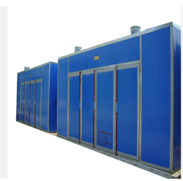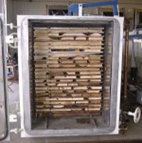
New and innovative technologies for firewood sanitation
December 7, 2023 - Emily Huff and Katherine Nocks, Michigan State University Extension
**MSU Extension does not endorse any company or technology. These comparisons are provided simply to demonstrate to producers the range of options available for heat treatment and kiln drying firewood.**
Firewood is often seasoned by simply exposing cut and split wood to air for a period of time. This common method still carries risk that the seasoned wood will harbor insects and fungal pathogens that may spread when firewood is transported. Kiln drying or heat treating firewood is an option to speed up drying/seasoning time and eliminate these invasive pests. There are also new and emerging technologies that would also sanitize firewood, while reducing time from stup to stove. Here we review these emerging technologies, for producers and consumers to evaluate if they might be useful for firewood processing.
One example is infrared technology. These kilns would work by heating the moisture of the wood to a high enough temperature that it evaporates. However, according to the U.S. Forest Service Forest Products Laboratory, for the infrared technology to properly dry the wood it must be dried unstacked, exposing each side at a time. This likely makes the technology inefficient and impractical, as well as costly, for processing large volumes of firewood.
Another drying technology is microwave kilns. These kilns use the same principles as the infrared kilns, but use microwaves to heat the moisture in the wood instead of infrared. The microwave kilns are much more efficient at drying than the infrared kilns, however they do have a more expensive initial cost and take up a larger footprint. However, an added benefit of microwave kilns compared to traditional kilns is that they reduce air emissions.
The final drying technology reviewed are vacuum kilns. Reducing water from wood involves heating that water to boiling point, which can also be accomplished by adjusting air pressure. The greater the air pressure, the higher the corresponding boiling point. When we remove air pressure from the equation, it causes a significantly lower boiling point. In the context of firewood, a vacuum kiln can evaporate moisture faster and at much lower temperatures. This has many advantages including faster drying times and less risk of damaging the wood. Vacuum kilns are the most expensive technology of the three reviewed here.
Although these new approaches to drying and seasoning firewood have many advantages over traditional methods, their overall cost may prohibit wide scale adoption by producers unless the price of firewood can compensate for these initial investments, regulation requires firewood sanitation, or consumers demand products that have been seasoned and dried using these methods.
Infrared
How does it work?
Dries the wood by heating the moisture in the wood until it evaporates with infrared rays.
Advantages
- Completely autonomous (does not require monitoring)
- More easily movable (1230 x 650 x 1.5 mm and 5.7 kg)
- Can be used indoor or outdoors
- Lower initial cost
Disadvantages
- Not as efficient at drying
- “Since infrared radiation penetrates wood only to a slight degree it does not appear advantageous to use it as a source of heat for seasoning wood because the rate at which the interior wood heats will depend upon the surface temperature and not upon whether the surface temperature was established by absorption of infrared radiation or by contact with hot circulating air”
Microwave
How does it work?
Dries the wood by heating the moisture in the wood until it evaporates with microwaves.
Advantages
- Faster drying time then infrared
- Less risk of overheating
- Less/no dangerous emissions
Disadvantages
- Requires monitoring
- Much larger
- More expensive
Vacuum
How does it work?
The greater the air pressure, the higher the boiling point. Vacuum kilns remove air pressure from the equation, which means the boiling point is lower. With a lower boiling point, the moisture in the wood evaporates quicker.
Advantages
- Straighter/flatter lumber, less stressed and retains color better
- Faster drying times then either microwave and infrared
- No Volatile organic compounds (VOC) emissions
- Larger capacity
Disadvantages
- High cost
- Risk of over-drying
- Complex operations
Major Vacuum-Drying Technologies
- Conductive heating vacuum drying
- Cyclic vacuum drying
- Superheated steam vacuum drying
- Radio frequency & microwave vacuum drying
- Radio frequency vacuum drying
Examples
iDry: $60,000-$670,000


- Air-heated Vacuum Kilns
- iDry standard
- iDry plus
- Heating Plate Vacuum Kilns
- iDry turbo mini
- iDry turbo
- iDry turbo pro

- Vacuum Wood Drying Kiln: $8,000

Saga Professional HF/RF Machine Factory: $30,000-$50,000

- HF Vacuum Wood
- HFVD120-SA
- HFVD100-SA
- HFVD45-SA
- HFVD30-SA

- Vacupress 1000
- Vacupress 2000
- Vacupress 4000
- Vacupress 12000


- Microwave UVC system
- Microwave tunnel conveyor system
- Microwave batch oven machine
Cellencor: (microwaves)


- Continuous ovens
- Solid-state generators
- Batch ovens
MICOR
Components to create an infrared kiln system




 Print
Print Email
Email





